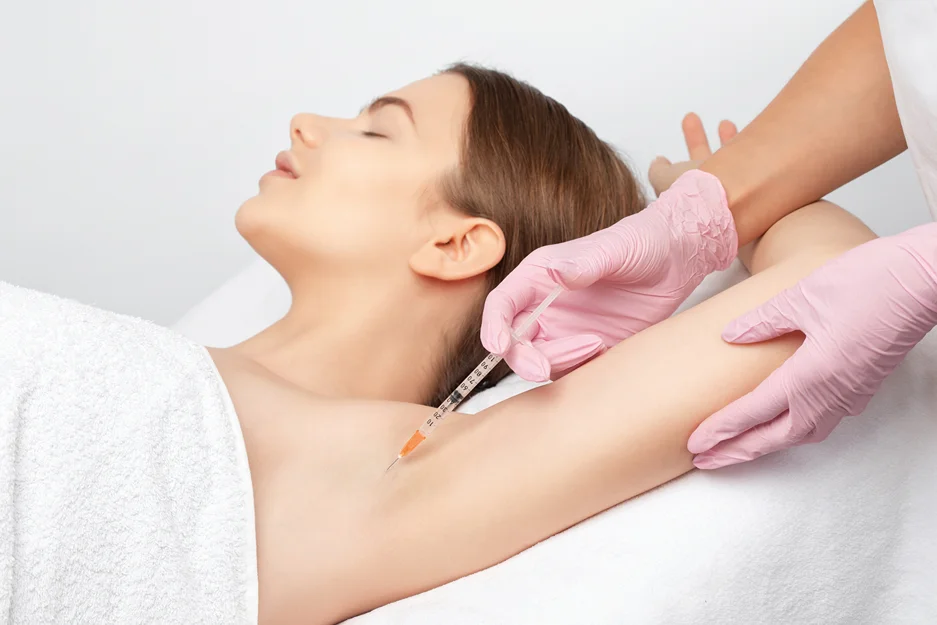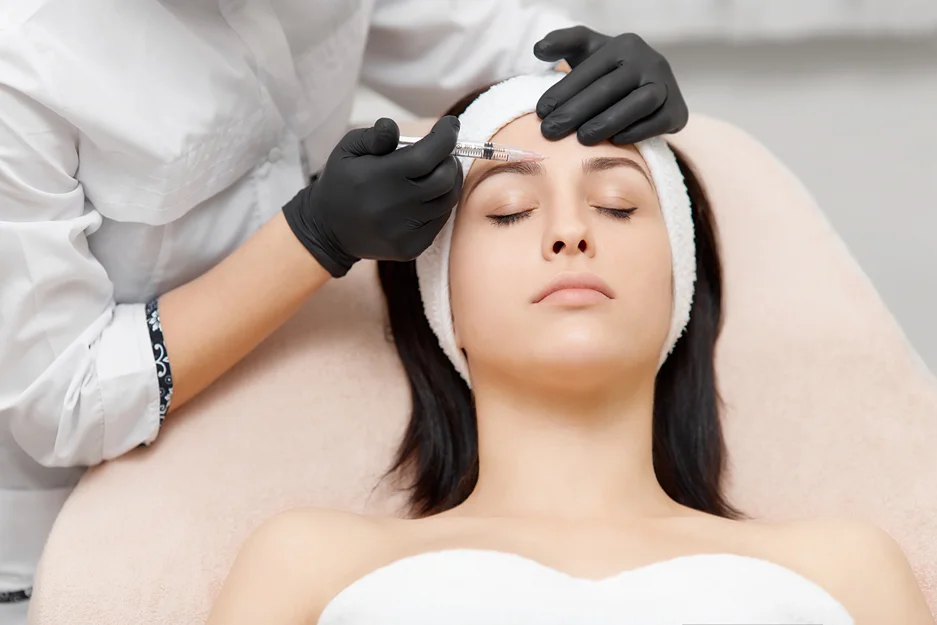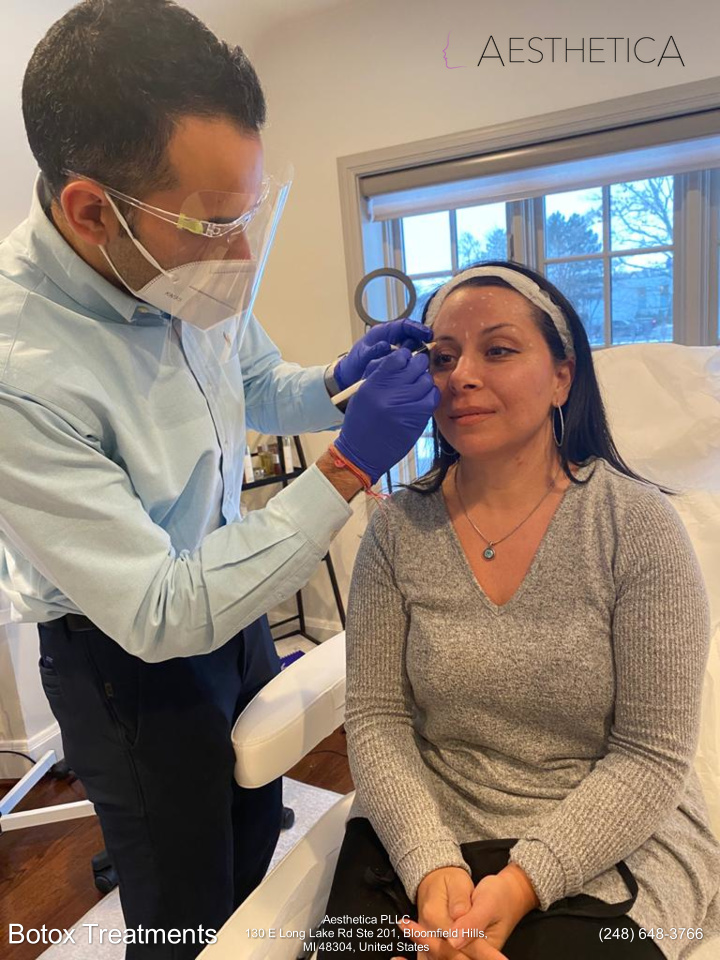
Sweating is a natural bodily reaction that helps regulate our body temperature, but it can be quite uncomfortable when you sweat through your clothes constantly. Sweating can become excessive and unbearable, especially when treatment attempts such as prescription-strength antiperspirants are ineffective. Cases like this are all likely due to focal hyperhidrosis, which means you have overactive sweat glands. Fortunately, this can be treated with Botox.
So how many units of Botox should be injected to treat excessive sweat production? A variety of factors determine how much Botox is required for you, which includes the severity of sweating and the area of concern. Depending on these conditions, most healthcare professionals may administer 10 to 100 units of Botox to reduce sweat production.
Aesthetica can assist you with all your beauty needs, helping you achieve your maximum beauty and aesthetic potential. Call or contact us today to learn more about our cosmetic services.
Botox has the potential to temporarily stop the secretion of a chemical that stimulates the eccrine glands in the entire body. Botulinum toxin prevents excessive sweating in the site where it’s injected by disrupting the chemical messengers that signal the body to produce sweat. Those who have tried and failed to stop excessive sweating with prescribed antiperspirants may consider this procedure.
The amount of Botox required varies from person to person and is determined by a variety of factors. Additionally, the number of Botox units needed depends on where on the body you’re administering the injections. Although Botox doesn’t spread throughout your body, it can spread 30 to 45 mm from the injection site.
To determine the number of Botox units required for treating excessive sweating, the location and severity are the most important considerations. A unit of Botox corresponds to how well it can relax the nerve signals it’s targeting through the strength of its botulinum toxin component.
For example, if you're treating excessive underarm sweating (axillary hyperhidrosis) with Botox, you should expect to use around 50 to 100 units. The severity of compensatory sweating in that area calls for extra units of Botox. In the case of axillary hyperhidrosis, around 50 units per armpit are typically used. But if the underarm sweat glands are more overactive, the doctor may inject 100 units per underarm.
In most circumstances, medical professionals will start with a standard set of guidelines for Botox units and then make adjustments based on relevant factors. The general guidelines provide suggestions for each of the facial areas or body parts affected by focal hyperhidrosis below:
Some injectable procedures, such as dermal fillers, are measured in syringes instead of units. The difference between Botox units and Botox syringes is that measuring in units allows your aesthetician to provide you with an effective treatment that includes the exact quantity of neurotoxin needed to relax your muscles.
Measuring in units allows you to be more flexible with your treatment strategy. While most units are distributed symmetrically on both sides, some require extra units on one side of the face in order to achieve the desired results. Instead of eyeballing with syringes, measuring by units guarantees accurate amounts are used.
Depending on how much excessive sweat production you wish to treat and where it is located, you may need additional units. While these units will never exceed 100 per treatment, more severe cases may necessitate additional units, which may mean you won't be able to treat other parts of your body with Botox if you don't have enough. According to the FDA, no more than 360 units of botulinum toxin should be administered within a 3-month period.
Though the location of the treated area is the most important aspect in determining how many units of Botox are required, there are several other factors to consider. With so many variables to consider, the easiest approach to figure out how many units of Botox you'll need is to schedule a consultation with healthcare professionals.
Examining muscular strength and its other properties may also be needed in order to determine how many Botox units are required for you. When estimating how many units of Botox you'll need, consider muscle strength and thickness. Stronger and thicker muscles will obviously require more Botox than weaker and thinner muscles.
Gender has a significant role in this decision. Because men have stronger muscles compared to women, they will require more Botox units. Men, on average, require 2 to 3 times the amount of Botox than women do.
The frequency with which muscles are used also plays an impact. To obtain the desired outcome, areas that are utilized more frequently may require more Botox units. If more units are administered to a well-used area, the treatment is more likely to be effective for longer.
It also matters what you hope to achieve with Botox. When prescription antiperspirants and deodorants aren't working, it depends if you wish to reduce or eliminate excessive armpit sweat. This will indicate the average number of Botox units required to get the desired outcomes.
Botox for hyperhidrosis is a great option for people who have tried everything else and still have excessive sweat that’s affecting their quality of life. Axillary hyperhidrosis is a common medical condition that causes excessive underarm sweating. Another example is palmar hyperhidrosis, or excessive palm sweating.
Metabolism is defined as "the breakdown of food and its transformation into energy," and it's another factor to consider when determining how many Botox units and how often you'll need them. Everyone’s metabolism is different, and this must be taken into account.
The effects of Botox usually last 3 to 4 months after treatment. People with a faster metabolism or who are physically active may require more procedures more frequently. Your body may process Botox injections at a different rate than other people's.
The body produces new neurotransmitters on a continuous basis. The Botox's effects start to fade as these new neurotransmitters spread throughout your body. Simply put, strenuous activity boosts your metabolism, causing Botox to wear off faster.
It's possible that Botox treatment effects could last longer over time since Botox weakens muscles with repeated use. The effects of Botox, regardless of how long you've been using it or how many units you've had injected, will ultimately wear off.
Botox effects last about 4 months on average. Although, if you have been regularly getting touch-up treatments for years, you can have results that last up to 6 months. If you're new to Botox, a general rule of thumb is to start with as few units as possible and gradually increase the number of units as needed to attain the best effects.
It’s quite possible that you’ll have to pay the whole cost of your Botox procedure if your insurance doesn’t cover it. Knowing your budget might help you make decisions about your treatment and how many units of Botox you can have.
If you're on a tight budget, start with a smaller area and work your way up as your budget allows. Additionally, it would be better to wait until you’re able to afford the total cost of a full treatment instead of settling for a partial one. There’s a possibility that you might not reach the results you would like and may need more medical treatments.

The amount of Botox used determines how relaxed the muscles are and, to some extent, how long the effects will last. It's critical to inject the appropriate number of units to achieve the desired result.
You prolong the effects of the Botox procedure if more units are administered. For example, if more units of Botox underarm injections are used, the duration of action may last longer than the average of 3 months.
It normally takes 2 to 4 days to see the results of the procedure and 2 weeks for the botulinum toxin injections to fully take action. However, Botox for focal hyperhidrosis isn't a long-term fix, but it can help you feel better. The neurotoxin's effect will eventually wear off, causing the nerves to send signals to the muscles to begin working or contracting again. Botox usually lasts 3 to 4 months.
There will undoubtedly be patients for whom it lasts longer, in the 4 to 6-month range, or for whom it lasts less, in the 2-month range. It's also normal for first-timers to observe that it doesn't last as long at first but does after the second session. Everyone has a different experience, so the outcomes may differ.
Botulinum toxin injections won’t cure excessive sweat production. Although, your symptoms will typically fade within a week and then return. To keep the skin dry, follow-up injections are required. Following the Botox procedure of any targeted location, you should see your healthcare practitioner in 1 to 2 weeks.
Follow-up treatment sessions are important. These sessions allow healthcare professionals to touch up any areas with excessive sweating that were missed during the initial treatment of Botox injections. Returning for a touch-up ensures that you get the full benefit of the treatment.
Additional injections may be required at intervals ranging from 7 to 16 months. The effects of treatment on the hands and feet may not stay as long, and you may need to repeat it after around 6 months. However, data on Botox's usefulness in these areas is very limited.

Excessive sweating could be more than uncomfortable for some people; it can also be inconvenient and disrupt daily life. Botox for sweating might feel like a lifesaver, especially when the improvement is so dramatic. In order to achieve optimal results from your treatment, the right dose of Botox units must be administered to produce your desired results.
At Aesthetica MI, we offer Botox hyperhidrosis injections to address your excessive sweating issues, as well as other medical treatments such as prescription topical antiperspirants or oral medications. Depending on your case, Botox could be the solution to your concerns with overactive sweat glands. Book a consultation with one of our specialists today for a Botox treatment plan (or alternative treatments) for your hyperhidrosis.
Aesthetica can assist you with all your beauty needs, helping you achieve your maximum beauty and aesthetic potential. Call or contact us today to learn more about our cosmetic services.